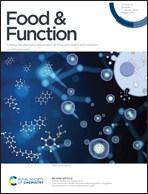Distinct breast milk microbiota, cytokine, and adipokine profiles are associated with infant growth at 12 months: an in vitro host–microbe interaction mechanistic approach†
Abstract
Breast milk (BM) is important for adequate infant development, and it contains bioactive compounds, such as bacteria, cytokines and some adipokines which play a role in infant microbial, metabolic, and immunological maturation. However, little is known about its impact on growth and development in early life. The objective of this study was to evaluate the impact of milk microbiota, cytokine, and adipokine profiles on the risk of overweight at 12 months of life to find the possible mechanisms of host–microbe interactions. In this study, BM samples from 100 healthy women collected during 15 d after birth were included. BM microbiota was analysed by 16S rRNA gene sequencing, and cytokine and adipokine levels were measured by the Luminex approach. In addition, infant weight and length were recorded during the first 12 months and z-scores were obtained according to the WHO databases. Infants were classified as risk of overweight (ROW) and no-risk of overweight (NOROW) based on their body mass index z-score (BMIZ) and infant weight-for-length z-score (WLZ) at 12 months. In order to study host–microbe interactions, epithelial intestinal and mammary cell lines were exposed to milk microbes to assess the host response by interleukin (IL)-6 production as a potential inflammatory marker. BM was dominated by Staphylococcus and Streptococcus genera, and the most abundant cytokines were IL-6 and IL-18. Leptin levels were positively correlated with the pregestational body mass index (BMI). Higher relative abundance of the Streptococcus genus was associated with higher IL-10 and higher relative abundance of the Bifidobacterium genus was associated with lower IL-6 concentrations in milk. Infant WLZ at 12 months could be partially predicted by Streptococcus genus proportions and IL-10 and IL-18 levels in BM. BM microbiota significantly induced cytokine responses in mammary epithelial cells. Higher levels of IL-6 production were observed in mammary cells exposed to BM microbiota from mothers with ROW offspring compared to mothers with NOROW offspring. In conclusion, BM microbiota is related to the cytokine profile. IL-10 and IL-18 levels and the abundance of the Streptococcus genus could affect early infant development. Further research is needed to clarify the specific impact of BM microbiota and cytokines on infant growth and the risk of overweight.



 Please wait while we load your content...
Please wait while we load your content...